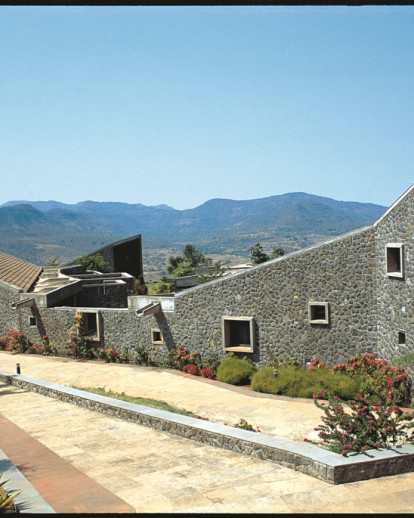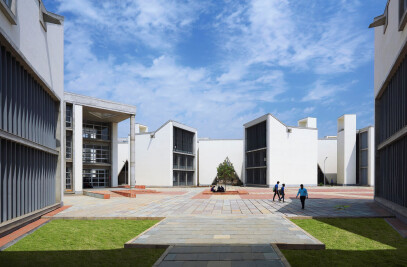This is one of the ten United World College public schools, headed by Nelson Mandela, located worldwide, patronized by the Indian auto industry family of The Mahindras. Here the students go through high school education. Twenty-five percent of the students are from India, the rest are from fifty-eight different countries. The purpose is to creat a global village with a marked sense of difference and community. This one is located in the cool western Sahyadri hills near Pune, about three hours by road from Mumbai.
Designed by expatriate American, Harvard and MIT educated architect Christopher Benninger who has lived in India for the past four decades. The site was chosen on a hill with a panoramic view of the breathtakingly beautiful verdant valleys below. The buildings are all made of local stone and exposed concrete, with gently sloping masonry surfaces, terracotta tiles roofs and square cut-outs in the walls for windows. The buildings are, from one point of view, a reflection of the mountains surrounding the campus, a kind of miniature model reflecting the jagged contours. But they are also like a village. Indeed, Benninger chose to break down the scale and articulate the units as in a small town as Aalto did at Saynatsalo. Taking his cue from the urban design theories of Joseph Luis Sert, the Dean of Harvard’s Graduate School of Design where Benninger taught in the 1960s, and of the “humanist” approach of Team Ten, also an influence at the time, Benninger centered the plans of this highly diverse little world around a quadrangle with passages radiating out from it. In other words, the plan is conceived as path driven. It offers points of encounter along the way, as well as views towards the valleys in the distance and a series of interconnected, flowing spaces.
All the students have their own small spatial domain and an individual sleep and study area. Like small wadas, the traditional courtyard houses of the region, eight students have to manage a small cottage surrounding a small courtyard, which is the social and spatial focus of each house. Just as traditional villages of the area are divided into clusters or wadis, so are the five faculty cottages. This vast network of crossing paths serves to bond the entire collage. The students’ and teachers’ units gravitate towards amenities for the entire campus which include a student centre, a swimming pool, a medical centre, a landscaped mall, a studio for graphics and music studio, as well as studios for dance and drama. It also includes a science centre, the administration building, a library and the dining hall. The complex conceived as a sequence of gardens, passages, stepped platforms, atria and orchards, each part having an identity of its own, a tension between chaos and control has won several awards including AIA-Business Week award in 2000. They allow the interpretation of the interior and the exterior spaces as well as the harmonious integration of the built form into the natural topography.
- Akkisetti Ramprasad

































